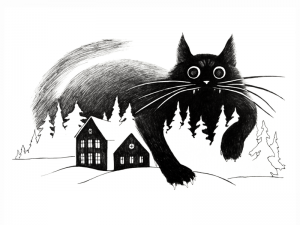
While Santa Claus is the central and typically solitary supernatural figure associated with Christmas for many Americans, European folklore is rife with other characters. A whole cast of such figures make their own annual Christmastime visits to evaluate children’s behavior and dole out corresponding rewards or punishments. Some of them supplement St. Nicholas, while others supplant him (consider Krampus and Belsnickel); some come from entirely separate traditions altogether. One such is the Yule Cat of Icelandic folklore.
The Jólakötturinn, or Yule Cat, is a monstrous feline taller than the tallest houses. At the end of the year, the creature lurks in the snow waiting to devour anyone who has not received new clothes for Christmas. Why new clothes? According to the National Museum of Iceland,
it was customary in the old rural [Icelandic] society that employers gave the employees in their home a new garment and sheepskin shoes for Christmas. This was done to reward the people for good work as the tasks that had to be accomplished before Christmas were numerous and therefore the weeks leading up to Christmas were characterized by a rigorous workload.
In this way, then, the Yule Cat rewards good behavior (hard work) and punishes slackers — perhaps a sensible ethic to promote given the harsh Icelandic climate.
